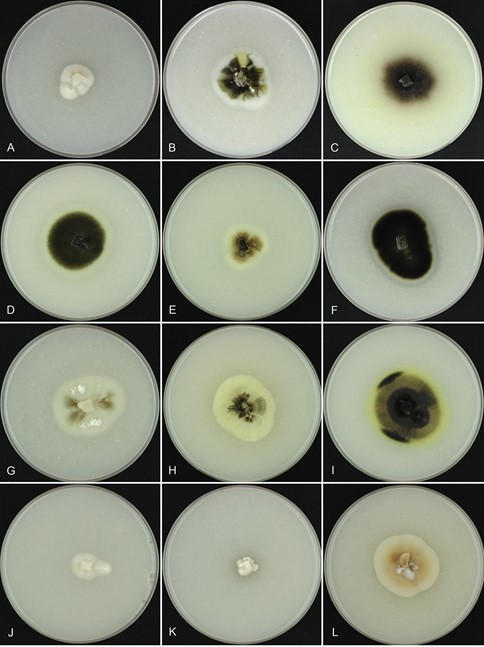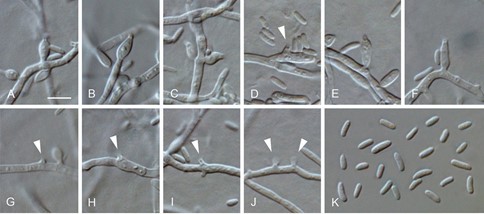Arboricolonus simplex S.Bien & Damm, MycoKeys 63: 130 (2020)
MycoBank number: MB 832107; Index Fungorum number: IF 832107; Facesoffungi number: FoF11363, Figures 5A, 6
Type. Germany, Saxony, orchard north of Wölkau, 50°58'42.3″N, 13°49'40.0″E, from brown wedge-shaped necrosis in wood of Prunus domestica, 16 Jan 2015, S. Bien leg., GLM-F106309 – holotype; GLMC 459 = CBS 145520 = DSM 109147 – culture ex-type.
Etymology. Named after the simple, reduced conidiophores.
Description. Sexual morph not observed. Asexual morph on SNA. Vegetative mycelium hyaline, smooth-walled, septate, branched, 1–3 μm wide, sometimes hyphal cells inflated and constricted at the septa, chlamydospores absent. Sporulation abundant, conidia formed on hyphal cells. Conidiophores reduced to conidiogenous cells. Conidiogenous cells enteroblastic, hyaline, smooth-walled, integrated or terminal, discrete phialides, ampulliform to navicular, 4–7 × 2–3 μm, often reduced to small necks or openings on hyphae, opening 0.5–1 μm wide, collarettes short tubular to funnel-shaped, 0.5–1 μm long, periclinal thickening sometimes visible. Conidia aggregated in heads or slimy mass- es around hyphae, hyaline, smooth-walled, aseptate, straight to ± curved, cylindrical, elongate ovoidal to allantoid, with one end rounded, the other end rounded to truncate, 3–4(–4.5) × 1–1.5(–2) μm, mean ± SD = 3.6 ± 0.6 × 1.3 ± 0.2 μm, L/W ratio = 2.8.
Culture characteristics. Colonies on OA flat to slightly raised with an entire to undulate margin, hyaline, whitish to buff, lacking aerial mycelium, reverse same colours, 2–4 mm diam. in 2 wk, 6–10 mm diam. in 4 wk; on SNA flat to slightly raised with an entire to undulate margin, hyaline to whitish, lacking aerial mycelium, reverse same colours, 1–2 mm diam. in 2 wk, 3–6 mm diam. in 4 wk.
Notes. The morphology of Arboricolonus simplex is reminiscent of collophorina- like species regarding the colonies that are slow growing, the lack of aerial mycelium and the conidiogenous cells that are mostly reduced to short necks or openings with collarettes on hyphae (Damm et al. 2010; Bien et al. 2020). In contrast to these genera, microcyclic conidiation has not been observed in Arboricolonus. This genus belongs to the Leotiomycetes as well; however, it is not closely related to Collophorina and collophorina-like genera (Phacidiales) treated by Bien et al. (2020). A class-wide phylogenetic analysis of LSU-ITS places it within the order Helotiales (data not shown). A blastn search with the ITS sequence of A. simplex in GenBank resulted in uncultured and unidentified strains with ≤ 92% identity, for example, an uncultured Helotiales clone from soil in the USA (HQ021771, JH Vineis et al., unpubl. data), while the closest matches with strains, identified at least to the genus level, were strains of Glutinomyces vulgaris with 90% identity (e.g. LC218288; Nakamura et al. 2018). The closest matches in a blastn search with the LSU sequence were, with ≤ 97% identity, the ex-type strain of Hyalodendriella betulae (EU040232; Crous et al. 2007), a strain identified as Chalara aurea (MH872551; Vu et al. 2019) and strains belonging to Polyphilus sieberi (e.g. MG719708; Ashrafi et al. 2018).

Figure 5. Colony surface of analysed strains on OA medium. A Arboricolonus simplex GLMC 459T B Cadophora africana CBS 120890T C C. bubakii CBS 198.30T D C. luteo-olivacea GLMC 1264 E C. no- vi-eboraci GLMC 1472 F C. obscura CBS 269.33 G C. prunicola CBS 120891T H C. prunicola GLMC 1633 I C. ramosa GLMC 377T J Minutiella pruni-avium GLMC 1624T K Proliferodiscus ingens GLMC 1751T L Proliferodiscus sp. GLMC 460. Cultures A, J–L after 4 wk. Cultures B–I after 2 wk. Strains with a superscript T are ex-type cultures.

Figure 6. Arboricolonus simplex gen. et sp. nov. A–J conidiogenous cells (arrows indicate conidiogenous openings or short necks) K conidia A–K from SNA A–K LM. Scale bar: 5 μm (A applies to B–K).
